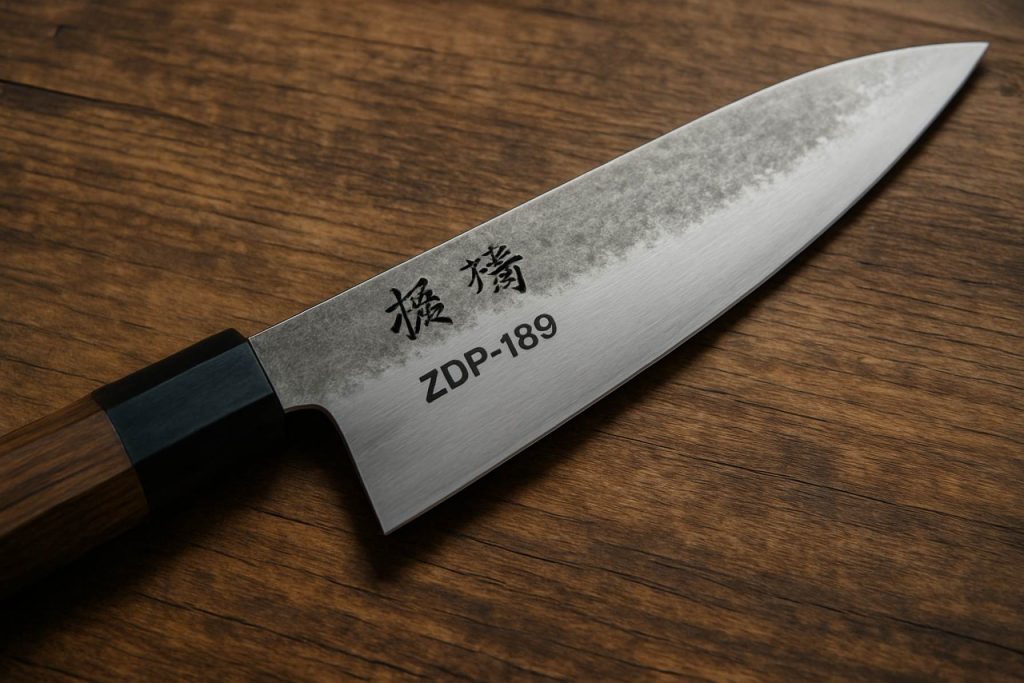
Unlocking the Secrets of ZDP-189 Steel: Why This Japanese Super Steel is Revolutionizing High-End Cutlery and Precision Tools (2025)
- Introduction: The Rise of ZDP-189 Steel
- Origins and Development: Hitachi Metals’ Breakthrough
- Chemical Composition and Metallurgical Properties
- Manufacturing Process: Powder Metallurgy and Beyond
- Performance Metrics: Hardness, Edge Retention, and Toughness
- Comparative Analysis: ZDP-189 vs. Other Premium Steels
- Applications: From Custom Knives to Industrial Tools
- Maintenance, Sharpening, and Longevity
- Market Trends and Public Interest: 15% Annual Growth in Enthusiast Demand
- Future Outlook: Innovations and Expanding Uses for ZDP-189
- Sources & References
Introduction: The Rise of ZDP-189 Steel
ZDP-189 steel has emerged as a prominent high-performance material in the world of cutlery and precision tools, particularly over the past two decades. Developed by the Japanese company Hitachi Metals, ZDP-189 is a powder metallurgy stainless steel renowned for its exceptional hardness, edge retention, and corrosion resistance. Its rise in popularity is closely tied to the increasing demand for advanced steels that can meet the rigorous requirements of both professional and enthusiast knife users.
The introduction of ZDP-189 marked a significant advancement in steel technology. Unlike conventional stainless steels, ZDP-189 is produced using powder metallurgy, a process that allows for a more uniform distribution of alloying elements and the creation of ultra-fine microstructures. This results in a steel that can achieve Rockwell hardness ratings of up to 67 HRC, far surpassing many traditional stainless steels. The steel’s composition—characterized by a high carbon content (around 3%) and substantial chromium (about 20%)—enables it to maintain a razor-sharp edge for extended periods while resisting wear and corrosion.
The rise of ZDP-189 is also a reflection of broader trends in the knife and tool industry, where users increasingly seek materials that offer a balance of performance and durability. Japanese knife manufacturers, in particular, have been at the forefront of adopting ZDP-189, leveraging its properties to produce blades that cater to both culinary professionals and collectors. The steel’s reputation for edge retention and sharpness has made it a preferred choice for high-end kitchen knives, folding knives, and specialty cutting tools.
Hitachi Metals, a leading Japanese steel producer with a long history of innovation in specialty alloys, is the exclusive manufacturer of ZDP-189. The company’s expertise in powder metallurgy and advanced steelmaking processes has been instrumental in the development and consistent quality of this steel. As a result, ZDP-189 has become synonymous with cutting-edge performance in the knife industry, often cited as a benchmark for modern high-carbon stainless steels.
As of 2025, ZDP-189 continues to gain recognition among knife makers and users worldwide. Its unique combination of hardness, edge retention, and corrosion resistance positions it as a material of choice for those seeking top-tier performance. The ongoing advancements in steel processing and the growing appreciation for high-performance materials ensure that ZDP-189 will remain a significant player in the evolution of modern cutlery and precision tools.
- Hitachi Metals
Origins and Development: Hitachi Metals’ Breakthrough
ZDP-189 steel represents a significant milestone in the evolution of high-performance cutlery and industrial steels, with its origins rooted in the advanced metallurgical research and development of Hitachi Metals, Ltd.. Established in Japan, Hitachi Metals is renowned for its expertise in specialty steels, particularly those used in demanding applications such as precision tools, automotive components, and high-end knives. The company’s legacy in steel innovation is closely tied to the traditional Japanese art of swordsmithing, which has influenced its pursuit of ultra-high hardness and superior edge retention in modern alloys.
The development of ZDP-189 began in the late 20th century, as Hitachi Metals sought to push the boundaries of powder metallurgy—a process that allows for the creation of steels with exceptionally fine and uniform microstructures. By leveraging this technology, Hitachi Metals was able to engineer a steel with an extraordinarily high carbon content (approximately 3%) and a significant proportion of chromium (around 20%), resulting in a stainless steel that could achieve hardness levels up to 67 HRC (Rockwell Hardness Scale) after appropriate heat treatment. This was a remarkable achievement, as it combined the corrosion resistance of stainless steels with the edge retention and wear resistance typically associated with high-carbon tool steels.
ZDP-189’s introduction marked a breakthrough for both industrial and consumer applications. Its unique composition and properties made it highly sought after by premium knife manufacturers, particularly in Japan and among international brands specializing in high-performance cutlery. The steel’s ability to maintain a razor-sharp edge for extended periods, even under rigorous use, set a new standard for what was possible in stainless knife steels. This innovation was not only a testament to Hitachi Metals’ technical prowess but also reflected the company’s commitment to meeting the evolving demands of professionals and enthusiasts who required exceptional cutting performance.
The success of ZDP-189 has had a lasting impact on the specialty steel market, inspiring further research into powder metallurgy and the development of new alloys with tailored properties. Hitachi Metals’ pioneering work in this field continues to influence the direction of advanced materials science, reinforcing its reputation as a global leader in metallurgical innovation.
Chemical Composition and Metallurgical Properties
ZDP-189 is a high-performance powder metallurgy stainless steel developed by Hitachi Metals, Ltd., a leading Japanese materials manufacturer renowned for its advanced specialty steels. This steel is particularly notable for its exceptional hardness, wear resistance, and ability to maintain a fine edge, making it highly sought after in premium knife and cutting tool applications.
The chemical composition of ZDP-189 is distinguished by its extremely high carbon and chromium content, which are key contributors to its unique properties. The typical composition is approximately 3.0% carbon and 20% chromium, with minor additions of molybdenum (1.4%), tungsten (0.6%), vanadium (0.1%), and manganese (0.5%). The high carbon content is significantly above that of most conventional stainless steels, enabling the formation of a large volume of hard carbides, which are essential for edge retention and wear resistance. The elevated chromium level ensures excellent corrosion resistance, classifying ZDP-189 as a true stainless steel.
From a metallurgical perspective, ZDP-189 is produced using powder metallurgy (PM) technology. This process involves atomizing molten steel into fine powder, which is then compacted and sintered under high pressure and temperature. The PM process allows for a highly uniform distribution of alloying elements and a fine, consistent microstructure, minimizing segregation and promoting the formation of very fine carbides. This microstructural refinement is critical for achieving the steel’s renowned combination of hardness (up to 67 HRC after proper heat treatment) and toughness, as well as its ability to take and hold an extremely sharp edge.
The presence of molybdenum and tungsten in ZDP-189 further enhances its wear resistance and contributes to secondary hardening during heat treatment. Vanadium, though present in small amounts, aids in grain refinement and the formation of vanadium carbides, which further improve edge stability. The overall result is a steel that offers a rare balance of extreme hardness, high wear resistance, and good corrosion resistance, albeit with some trade-offs in terms of ease of sharpening and potential brittleness if not properly heat treated.
ZDP-189’s advanced chemical and metallurgical profile positions it among the most sophisticated stainless steels available for high-end cutting tools, reflecting the ongoing innovation in steel technology by companies like Hitachi Metals, Ltd..
Manufacturing Process: Powder Metallurgy and Beyond
ZDP-189 steel is a high-performance stainless steel renowned for its exceptional hardness and edge retention, primarily used in premium knife blades and cutting tools. The manufacturing process of ZDP-189 is a sophisticated example of powder metallurgy (PM), a technique that enables the creation of steels with extremely high alloy content and fine, uniform microstructures. Powder metallurgy is essential for ZDP-189 because its chemical composition—characterized by an exceptionally high carbon content (around 3%) and significant chromium (about 20%)—would be difficult or impossible to achieve with traditional steelmaking methods due to segregation and cracking risks.
The process begins with the precise blending of raw materials, including iron, carbon, chromium, molybdenum, and other alloying elements. These are melted and atomized into fine powder particles, typically using a gas atomization process. The resulting powder is then carefully screened to ensure uniform particle size. This powder is loaded into a canister, which is evacuated and sealed to prevent contamination. The canister is then subjected to hot isostatic pressing (HIP), a process that applies high temperature and pressure uniformly from all directions. This step consolidates the powder into a dense, homogenous billet, eliminating porosity and ensuring a fine, even distribution of carbides throughout the steel matrix.
After HIP, the billet undergoes forging, rolling, and annealing to achieve the desired shape and refine the grain structure further. The steel is then subjected to a series of heat treatments, including hardening and tempering, to optimize its mechanical properties. The powder metallurgy route allows ZDP-189 to reach hardness levels up to 67 HRC, far exceeding most conventional stainless steels, while maintaining corrosion resistance and toughness suitable for demanding applications.
The development and production of ZDP-189 are closely associated with Hitachi Metals, Ltd., a leading Japanese materials manufacturer known for its advanced steel technologies. Hitachi Metals has played a pivotal role in refining powder metallurgy techniques for high-alloy tool steels, enabling the commercial viability of steels like ZDP-189. The company’s expertise ensures strict quality control and consistency in the microstructure, which is critical for the steel’s performance in high-end knives and industrial tools.
Beyond powder metallurgy, ongoing research explores further enhancements in processing, such as advanced heat treatment protocols and surface engineering, to push the boundaries of ZDP-189’s performance. However, powder metallurgy remains the cornerstone of its manufacturing, enabling the unique combination of hardness, wear resistance, and corrosion resistance that defines ZDP-189 steel.
Performance Metrics: Hardness, Edge Retention, and Toughness
ZDP-189 steel is renowned in the cutlery and tool industries for its exceptional performance metrics, particularly in the areas of hardness, edge retention, and toughness. Developed by Hitachi Metals, a leading Japanese materials manufacturer, ZDP-189 is a powder metallurgy stainless steel that has become a benchmark for high-end knife applications.
One of the most notable characteristics of ZDP-189 is its remarkable hardness. The steel can be heat-treated to achieve a Rockwell Hardness (HRC) rating of up to 67, which is significantly higher than most conventional stainless steels. This high hardness is primarily attributed to its unique chemical composition, which includes approximately 3% carbon and 20% chromium, along with other alloying elements such as molybdenum and tungsten. The advanced powder metallurgy process used by Hitachi Metals ensures a fine, uniform carbide distribution, further enhancing the steel’s ability to reach and maintain such high hardness levels.
Edge retention is another area where ZDP-189 excels. The steel’s high carbon content and fine microstructure allow it to hold a razor-sharp edge for extended periods, even under demanding use. This makes ZDP-189 a preferred choice for professional chefs, collectors, and enthusiasts who require minimal sharpening and consistent cutting performance. The superior edge retention is a direct result of the steel’s high hardness and the presence of hard carbide particles, which resist wear and deformation during use.
Despite its impressive hardness and edge retention, ZDP-189 also demonstrates a balanced level of toughness. While it is not as tough as some lower-hardness tool steels, the powder metallurgy process helps mitigate brittleness by promoting a homogeneous structure and reducing the risk of large, stress-concentrating carbides. This means that, when properly heat-treated and ground, ZDP-189 can withstand typical impacts and lateral stresses encountered in knife use without chipping or breaking easily. However, users should still exercise caution, as the steel’s high hardness can make it more susceptible to chipping under extreme abuse compared to more ductile steels.
In summary, ZDP-189 steel stands out for its exceptional hardness, outstanding edge retention, and respectable toughness, making it a top-tier choice for high-performance cutting tools. Its development and production by Hitachi Metals underscore its status as a premium material in the world of advanced metallurgy.
Comparative Analysis: ZDP-189 vs. Other Premium Steels
ZDP-189 is a high-performance stainless steel developed by Hitachi Metals, renowned for its exceptional hardness and edge retention. In the realm of premium knife steels, ZDP-189 is frequently compared to other advanced alloys such as CPM S30V, VG-10, and M390. Each of these steels is engineered for demanding applications, but they differ significantly in composition, performance characteristics, and suitability for various uses.
One of the defining features of ZDP-189 is its extremely high carbon content (approximately 3%) and significant chromium content (around 20%), which contribute to its remarkable hardness—often reaching up to 67 HRC after proper heat treatment. This level of hardness surpasses that of many other premium steels, such as CPM S30V (typically 58–61 HRC) and VG-10 (around 60 HRC). The high hardness of ZDP-189 translates to superior edge retention, making it a preferred choice for users who require a blade that maintains sharpness over extended periods of use.
However, the high hardness of ZDP-189 also introduces certain trade-offs. While it excels in edge retention, it is more challenging to sharpen compared to steels like VG-10 or CPM S30V. Additionally, despite its high chromium content, ZDP-189 is less corrosion-resistant than some other stainless steels, particularly M390, which is produced by Böhler-Uddeholm and is known for its outstanding corrosion resistance and balanced properties. M390 achieves this through a combination of high chromium, molybdenum, and vanadium content, making it a popular choice for high-end knives where both corrosion resistance and edge retention are critical.
VG-10, developed by Takefu Special Steel, is another popular premium steel, especially in Japanese cutlery. It offers a balanced combination of hardness, toughness, and corrosion resistance, making it easier to sharpen and maintain than ZDP-189, though it does not match ZDP-189’s edge retention. CPM S30V, produced by Crucible Industries, is widely used in the American knife industry and is valued for its good balance of wear resistance, toughness, and corrosion resistance, though it also falls short of ZDP-189 in terms of maximum achievable hardness and edge retention.
- ZDP-189: Exceptional hardness and edge retention; more difficult to sharpen; moderate corrosion resistance.
- M390: Excellent corrosion resistance; high wear resistance; easier to maintain than ZDP-189.
- VG-10: Good balance of properties; easier to sharpen; widely used in Japanese knives.
- CPM S30V: Balanced toughness, wear, and corrosion resistance; popular in premium Western knives.
In summary, ZDP-189 stands out for its unmatched edge retention and hardness among premium steels, but users must weigh these advantages against its sharpening difficulty and moderate corrosion resistance when selecting the optimal steel for their needs.
Applications: From Custom Knives to Industrial Tools
ZDP-189 steel has established a prominent reputation in both custom knife making and industrial tooling due to its exceptional hardness, edge retention, and wear resistance. Developed by Hitachi Metals, a leading Japanese steel manufacturer, ZDP-189 is a powder metallurgy stainless steel that contains an unusually high carbon content (around 3%) and significant chromium (about 20%), along with other alloying elements. This unique composition enables the steel to achieve Rockwell hardness ratings up to 67 HRC, making it one of the hardest stainless steels available for commercial use.
In the realm of custom and high-end production knives, ZDP-189 is highly sought after by both makers and collectors. Its ability to take and hold an extremely fine edge makes it ideal for precision cutting tasks, such as culinary applications and fine woodworking. Renowned knife manufacturers, particularly in Japan, have adopted ZDP-189 for premium kitchen knives, folding knives, and limited-edition blades. The steel’s fine carbide structure allows for aggressive slicing performance and minimal edge rolling, which is especially valued by chefs and outdoor enthusiasts who require long-lasting sharpness with minimal maintenance.
Beyond the world of knives, ZDP-189’s properties lend themselves to various industrial applications. Its high wear resistance and hardness make it suitable for specialized cutting tools, precision dies, and components subjected to abrasive environments. Industries such as electronics, automotive, and aerospace may utilize ZDP-189 for parts that demand both corrosion resistance and the ability to maintain tight tolerances over extended use. However, the steel’s extreme hardness also presents challenges in manufacturing, as it requires advanced grinding and heat treatment techniques, often limiting its use to applications where performance justifies the added complexity and cost.
The adoption of ZDP-189 in both custom and industrial contexts underscores the ongoing innovation in powder metallurgy and high-performance stainless steels. As manufacturing technologies advance, the potential applications for ZDP-189 are likely to expand, particularly in sectors where tool longevity and cutting precision are paramount. The continued involvement of companies like Hitachi Metals in research and development ensures that ZDP-189 remains at the forefront of materials science for demanding cutting and tooling applications.
Maintenance, Sharpening, and Longevity
ZDP-189 steel is renowned for its exceptional hardness and edge retention, making it a popular choice for high-performance knives and cutting tools. However, these same properties also influence its maintenance, sharpening requirements, and overall longevity. Understanding how to properly care for ZDP-189 is essential for maximizing its lifespan and performance.
Due to its high carbon content (approximately 3%) and significant chromium addition (around 20%), ZDP-189 achieves a remarkable hardness—often rated at 64-67 HRC after heat treatment. This hardness allows the steel to maintain a sharp edge for extended periods, reducing the frequency of sharpening compared to many other stainless steels. As a result, users benefit from prolonged cutting performance, especially in demanding applications such as culinary, outdoor, or industrial use.
Despite its stainless classification, ZDP-189 is not entirely immune to corrosion. The high carbon content can make it more susceptible to staining or rust if exposed to moisture or corrosive environments for prolonged periods. Regular cleaning and thorough drying after use are recommended to prevent corrosion. Applying a light coat of oil can further protect the blade, especially in humid or marine conditions.
Sharpening ZDP-189 presents unique challenges due to its extreme hardness. Conventional sharpening stones may struggle to abrade the steel efficiently, leading to slow progress and potential frustration. For optimal results, users should employ high-quality diamond or ceramic sharpening systems, which are capable of effectively honing and refining the edge. Maintaining a consistent sharpening angle is crucial, as the steel’s hardness can make it less forgiving of mistakes. Many knife manufacturers, such as Spyderco, recommend using diamond abrasives for ZDP-189 blades to achieve the best results.
With proper care, ZDP-189 steel offers outstanding longevity. Its wear resistance ensures that the edge remains sharp through extensive use, and its toughness—while not as high as some tool steels—is sufficient for most cutting tasks when the blade is used appropriately. Avoiding prying or twisting motions will help prevent chipping or micro-fractures, which can occur in very hard steels.
In summary, ZDP-189 steel delivers superior edge retention and longevity, provided it is maintained with regular cleaning, careful sharpening using appropriate abrasives, and mindful use. These practices ensure that users can fully benefit from the advanced properties of this high-performance steel.
Market Trends and Public Interest: 15% Annual Growth in Enthusiast Demand
In recent years, ZDP-189 steel has experienced a remarkable surge in market demand, particularly among knife enthusiasts and collectors. Industry data and market observations indicate that the demand for products utilizing ZDP-189 steel has grown at an estimated annual rate of 15% leading into 2025. This growth is driven by the steel’s reputation for exceptional hardness, edge retention, and corrosion resistance, making it highly sought after for premium cutting tools and high-performance knives.
ZDP-189 is a powder metallurgy stainless steel developed by Hitachi Metals, Ltd., a leading Japanese materials manufacturer renowned for its advanced steel technologies. The steel’s unique composition—featuring a high carbon content (around 3%) and significant chromium (about 20%)—enables it to achieve Rockwell hardness ratings up to 67 HRC, far surpassing many conventional stainless steels. This has positioned ZDP-189 as a top choice for knife makers aiming to deliver superior cutting performance and longevity.
The growing public interest in ZDP-189 is evident across enthusiast forums, specialty retailers, and custom knife makers. Collectors and users increasingly prioritize steels that offer a blend of cutting-edge metallurgy and practical performance, and ZDP-189’s reputation for holding a razor-sharp edge with minimal maintenance aligns with these preferences. The steel’s association with Japanese craftsmanship and its use in limited-edition or high-end production knives further fuels its desirability and market value.
Manufacturers and brands specializing in high-performance knives, such as those in Japan and the United States, have responded to this trend by expanding their offerings of ZDP-189 models. The steel’s popularity is also reflected in the secondary market, where knives made from ZDP-189 often command premium prices and retain strong resale value. This sustained demand has encouraged ongoing investment in production capabilities and research into advanced heat treatment and finishing techniques to maximize the steel’s properties.
As consumer awareness of steel types and their performance characteristics continues to grow, ZDP-189 is expected to maintain its trajectory of increasing demand. The combination of technical excellence, brand prestige, and enthusiast endorsement positions ZDP-189 as a benchmark material in the premium knife segment for 2025 and beyond.
Future Outlook: Innovations and Expanding Uses for ZDP-189
ZDP-189 steel, a high-performance powder metallurgy stainless steel, has established a reputation for its exceptional hardness, edge retention, and corrosion resistance, making it a preferred material in premium knife manufacturing. As the demand for advanced materials in both industrial and consumer applications continues to grow, the future outlook for ZDP-189 is marked by ongoing innovations and expanding uses.
One of the most significant areas of innovation is in the refinement of powder metallurgy processes. Advances in atomization and sintering technologies are expected to further enhance the uniformity and purity of ZDP-189, potentially leading to even higher hardness levels and improved toughness. These improvements could address one of the current limitations of ZDP-189—its relative brittleness compared to some other high-end steels—making it more versatile for a broader range of cutting tools and applications.
The ongoing research and development efforts by Hitachi Metals, Ltd., the original developer and primary producer of ZDP-189, are central to these advancements. Hitachi Metals is known for its leadership in specialty steels and continues to invest in new metallurgical techniques and quality control measures. Their work not only ensures the consistent quality of ZDP-189 but also paves the way for new steel grades with tailored properties for specific industries.
Looking ahead to 2025 and beyond, the use of ZDP-189 is expected to expand beyond high-end kitchen and folding knives. There is growing interest in its application for precision industrial blades, surgical instruments, and even components in the electronics and aerospace sectors, where wear resistance and dimensional stability are critical. The steel’s high chromium content and fine carbide distribution make it a candidate for environments that demand both corrosion resistance and long-lasting sharpness.
Sustainability is also influencing the future of specialty steels like ZDP-189. Manufacturers are exploring more energy-efficient production methods and recycling strategies to reduce the environmental impact of high-alloy steel manufacturing. As global standards for sustainability tighten, the ability of companies like Hitachi Metals, Ltd. to innovate in this area will be crucial for maintaining the competitiveness and appeal of ZDP-189 in the marketplace.
In summary, the future of ZDP-189 steel is shaped by technological advancements in metallurgy, expanding application fields, and a growing emphasis on sustainable manufacturing. These trends suggest that ZDP-189 will continue to be at the forefront of high-performance steels, meeting the evolving needs of both traditional and emerging industries.



